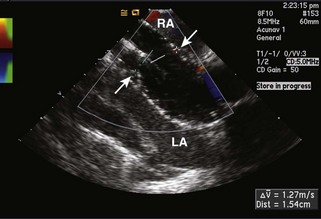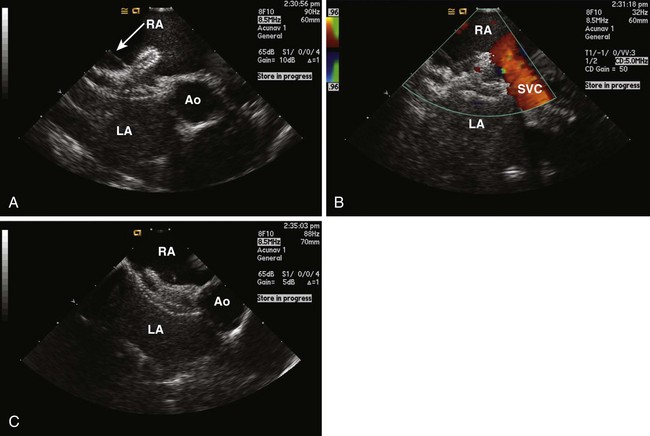3 Echocardiography in the Cardiac Catheterization Laboratory
Echocardiographic Techniques
Real-time three-dimensional (3D) echocardiography is a more recently developed technique that can be used to image the anatomy, catheters, and devices. It allows for improved understanding of the relationships between the device and cardiac structures. The image quality and resolution are inferior to those of the other 2D techniques (Table 3-1).
Transcatheter Closure of Atrial Septal Defects/Patent Foramen Ovale
Technique
Step-by-Step Approach
1 Assess Anatomy
Secundum ASDs and PFO are amenable to transcatheter closure.
Key Points
• Before closure attempt, the anatomy of the atrial septum (AS) is assessed. Morphology, maximum diameter, defect number, total septal length, adequacy of the rims, and distance of the defect from the surrounding structures must be determined (Fig. 3-1).
• The assessment for a PFO should include the length of the tunnel and the assessment of an associated atrial septal aneurysm. An intravenous injection of agitated saline solution bubbles is performed to identify the presence of a right-to-left shunt.
• The Eustachian valve should be assessed. A large Eustachian valve or Chiari network does not preclude the ability to place a device.
• Color Doppler should be performed to assess for additional defects and the presence of fenestrations.
• The devices that are currently available are indicated for secundum ASDs and PFO. The exact location of the defect needs to be determined.
• The pulmonary veins (PVs) should be assessed. The presence of partial anomalous pulmonary venous return may indicate surgical referral to address both anomalies.
2 Dynamic Sizing
A sizing balloon is often used to measure the stretched diameter of the ASD.
Key Points
3 Device Placement
Key Points
• The left atrial disk of the device is deployed first. A view with good visualization of the mitral valve (MV) and AS is required. The left atrial disk should be free in the left atrium (LA) during extrusion from the sheath. It should not be opened in the PVs, left atrial appendage, or MV.
• After the device has been fully deployed, echocardiography should determine whether all the rims have been captured. Often the interventional cardiologist will need to “wiggle” the device to help visualize the rims within the space between the right and left disks.
• The relationship of the deployed device to the MV, pulmonary venous return, and superior vena cava (SVC) is important before final release of the device (Fig. 3-3). Any interference with these cardiac structures most often is an indication for device removal.











